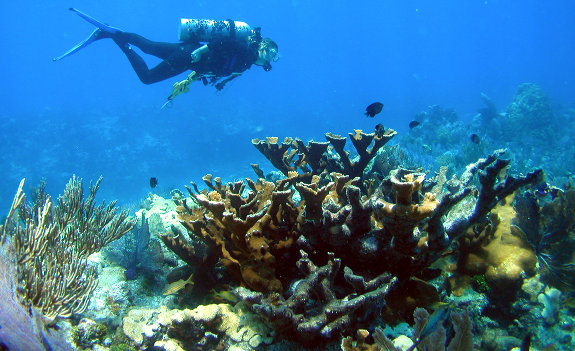
Disease-free coral colonies are rare during a White Pox disease outbreak, but some colonies (such as those shown here from Molasses Reef) may have natural resistance to this bacterium and may live to recolonize the reef. (Photo by James W. Porter of the University of Georgia.)
By Ralph De La Cruz
Florida Center for Investigative Reporting
Anyone who visited the Florida Keys in the late 1980s and then recently revisited would know: the coral are dying. Live Caribbean elkhorn coral, in particular, are almost nonexistent.
And for years, nobody really knew why.
On Wednesday, researchers from Florida’s Rollins College and the University of Georgia said they had figured out the scientific whodunit.
So who or what is killing the elkhorn?
We are. One flush at a time. The elkhorn, it turns out, are dying from human pathogens found in our wastewater.
Rollins College and University of Georgia researchers had known since 2002 that white pox was caused by the bacteria serratia marcescens — and that the serratia marcescens came from waste.
But until they were able to isolate the human strain and test it on elkhorn coral in closed seawater tanks at the Mote Marine Laboratory in Tavernier, they couldn’t know if the waste came from humans or some other animals, such as Key deer or seagulls.
When they inoculated the elkhorn coral with the strain from other animals, it didn’t die.
“The (human) strain caused disease in elkhorn coral in five days, so we now have definitive evidence that humans are a source of the pathogen that causes this devastating disease of corals,” said Kathryn P. Sutherland, an associate professor of biology at Rollins College.
“These bacteria do not come from the ocean — they come from us,” said James Porter, a University of Georgia ecology professor who pointed out that water-related activities in the Florida Keys alone bring $3 billion to the local and state economy.
Once among the most abundant coral in the Caribbean, elkhorn were placed on the federal endangered species list in 2006.
But Porter is optimistic about being able to get serratia marcescens under control.
“Bacteria from humans kill corals — that’s the bad news,” Porter said. “But the good news is that we can solve this problem with advanced wastewater treatment facilities.”
The Keys are upgrading local wastewater treatment plants — a move that is supposed to help eliminate the elkhorn killer.
Of course, that doesn’t help the bleaching of coral, which is caused by rising water temperatures and increasingly acidic seawater. Or the choking-off of the reefs by nutrients found in fertilizers and untreated waste — such as the wastewater spills that closed South Florida beaches last Labor Day weekend.
At nascent reefs north of the Keys, things aren’t likely to be getting better — not after legislators cut $500,000 from the Department of Health, which then cut its beach-monitoring program in half.
Last year, the state cited 24 undisclosed beaches for posing significant health risks. And yet, as a result of the cuts, there won’t be beach water monitoring at all in Florida during the winter, from November to February. At 45 beaches, it’ll be gone for good. And for the others, it’ll only be checked every other week.
Luckily, other researchers at Mote Marine Laboratory are working on how to re-grow coral. That may be easier than figuring out how to change collective human behavior.
“We have lost 25 percent of the world’s corals in the last 25 years,” David E. Vaughan, director of the Center for Coral Reef Research at Mote, said in a 2007 interview, adding that 25 percent more were expected to die in the next decade or two.
“Sometimes we sound like doomsday sayers,” Vaughan said, “but those are the facts.”
